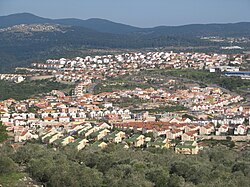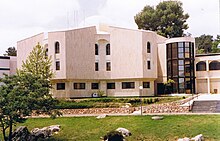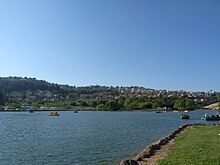Ma'alot-Tarshiha
Ma'alot-Tarshiha
| |
|---|---|
City (from 1996) | |
| Hebrew transcription(s) | |
| • ISO 259 | Maˁlot Taršiḥaˀ |
| • Translit. | Maʻalot-Tarshiḥa |
 | |
| Coordinates: 33°1′0″N 35°16′15″E / 33.01667°N 35.27083°E | |
| Grid position | 175/268 PAL |
| Country | |
| District | Northern |
| Founded | 12th century |
| Government | |
| • Mayor | Arkady Pomeranets |
| Area | |
| • Total | 9,220 dunams (9.22 km2 or 3.56 sq mi) |
| Population (2022)[1] | |
| • Total | 22,521 |
| • Density | 2,400/km2 (6,300/sq mi) |
| Name meaning | Teir Shiha: Teir, a fortress. Shih is a fragrant herb.[2] |
| Website | http://www.maltar.org.il/English/Pages/default.aspx |
Ma'alot-Tarshiha (
As of 2022, the city had a population of 22,521.[3]
History
Tarshiha
Excavations of a 4th-century burial cave in the village, unearthed a
Crusader sources from the 12th and 13th century refer to Tarshiha as Terschia, Torsia, and Tersigha.[5] The King had initiated the settlement of Crusader (Latin, Frankish) people in nearby Mi'ilya ("Castellum Regis"), and from there settlement spread out to Tarshiha.[6] In 1160, Torsia and several surrounding villages were transferred to a Crusader named Iohanni de Caypha (Johannes of Haifa).[7]
By 1217, the village was probably inhabited by Crusader ("Frankish") people.
According to popular Arabic etymology,[
Ottoman era
Incorporated into the
In the early eighteenth century, the village was under control of Shaikh Husayn,
Victor Guérin, who visited in 1875, found that Tarshiha "consists of four quarters, under the jurisdiction of as many different sheikhs. There are 2,000 Moslems, who have their mosques. The Christians occupy their own quarters: with the exception of a few families they are all Uniate Melkite Greeks, and number about 500."[16] In 1881 the Palestine Exploration Fund's Survey of Western Palestine described Tarshiha as: "a very large village, containing about 1,500 Moslems and 300 Christians; there is a fine mosque with minarets newly built, also an old one; the houses are well-built; a new and handsome church has been built in the Christian quarter".[17]
A population list from about 1887 showed Tarshiha to have about 4,855 inhabitants; 4,000 Muslims and 855 Christian.[18]
British Mandate era

In the
In the
Residents of Ma'alot-Tarshiha interviewed in early 1980s recalled Tarshiha as being the leading village in the area with a population of 3,000 including 700 Christians. The Christians had established a successful handcrafts industry. The villages main crop was tobacco. There was a tobacco growers union which ran a trucking cooperative. In the mid 1930s it was learnt that the
1947-48 war
During the
Following the establishment of the state of Israel Tarshiha was surrounded on three sides by the
State of Israel
In the
Any Arab who had not registered, as of November 1948, was regarded as illegal and if caught deported. An American Quaker relief worker with the
The abandoned houses in Tarshiha were initially taken over by Jews from Romania. When they were moved on to new settlements the houses were demolished. Around 600 villagers remained after 1948. They were joined by others expelled from nine other local villages.[31]
Ma'alot

Ma'alot was established as a development town for Jewish immigrants from Romania, Iran and Morocco, in 1957. The first homes were built on Har HaRakafot (Cyclamen Hill), known in Arabic as Bab Al-Hauwa ("Gate of the Winds").[citation needed]
Ma'alot-Tarshiha merger
In 1963, Ma'alot was merged with the larger Tarshiha, and the unified town was renamed to reflect both origins. The inhabitants of Tarshiha hoped that the merger would improve the level of services.
On 15 May 1974, an elementary school in Ma'alot was attacked by terrorists of the Democratic Front for the Liberation of Palestine in what became known as the Ma'alot massacre.[40] Twenty-two teenagers and three teachers from Safed on a class trip were murdered in the attack. They had been sleeping on the floor inside the building.[41] In addition, three Israeli women, one of them seven months pregnant, one four-year-old child, and two men were killed by the same terrorists in the events before the murder of the school children.[42]
A visitor in 1980 estimated that half of the 2,400 Arabs living in the town originated from Tarshiha. 70% of those with jobs worked in the building trade, none of them were farmers. The 3,500 Jewish residents were mostly Moroccan. Few of whom stayed for long periods.[43]
During the 1990s post-Soviet aliyah in the 1990s, many immigrants settled in the city.[44]
Ma'alot-Tarshiha was officially recognized as a city in 1996.
Nearly 700
Demographics

In 2016, ethnic and religious makeup of the city was 79.2%
As of 2016, there were 10,503 salaried workers and 564 self-employed persons in the city. The mean monthly wage in 2016 for a salaried worker was
Following Israel's withdrawal from Lebanon in 2000 some ex South Lebanon Army soldiers and officers who fled from Lebanon settled in Ma'alot with their families.[47]
Economy

The Tefen Industrial Zone, which includes famous companies such as the
Education

In 2001, there were 11 schools and 4,272 students in the city, including 7 elementary schools with an enrollment of 2,000, and 7 high schools with 2,272 students. 58.5% of the city's 12th graders earned a matriculation certificate in 2001. In August 1975, Yeshivat Ma'alot, a Hesder yeshiva, was established, attracting students from all over the world. In recent years the Yeshiva has estimated 300 students per year.
Landmarks and culture

Victor Guérin, after his 1875 visit, wrote that the principal mosque in Tarshiha had been built by Abdullah Pasha, (the Governor of Acre at the time.) He further noted that it was "preceded by a court, then by a porch; surmounted by a cupola, above which springs an elegant minaret."[49] Andrew Petersen, who inspected the mosque in 1993, noted that it was built in "classical Ottoman style with four main elements: a courtyard, an arcade, a domed prayer hall, and a minaret."[50]

Lake Monfort, an artificial lake to the east of Ma'alot-Tarshiha, has become a local tourist attraction. It was previously known as the Hosen Reservoir. The lake is featured in the city's emblem.[citation needed]
In January 2008, Ma'alot-Tarshiha hosted the Israel International Chess Championship. The tournament, held at the community center, carried a prize of $20,000. The city has also hosted other international events, among them an international fencing tournament.[51] The "Stone in the Galilee" International Sculpture Symposium has been held annually in Ma'alot-Tarshiha since 1991. In this 10-day springtime event, sculptors from Israel and around the world convene at Montfort Lake to create stone sculptures from huge blocks of stone.[52]
In 2009, the non-profit Docaviv established an annual documentary film festival in the city in an effort to bring "high quality cultural activity to the Israeli periphery."[53]
Notable people
- Ashraf Barhom (born 1979), actor
- Amal Bishara, doctor
- Nisreen Faour (born 1972), actress
- Mahmoud Hawari
Twin towns – sister cities
 Birobidzhan, Russia
Birobidzhan, Russia Harrisburg, United States[54]
Harrisburg, United States[54] Asti, Italy
Asti, Italy Reichenbach im Vogtland, Germany
Reichenbach im Vogtland, Germany Perpignan, France
Perpignan, France- Quba, Azerbaijan
References
- ^ "Regional Statistics". Israel Central Bureau of Statistics. Retrieved 21 March 2024.
- ^ Palmer, 1881, p. 55
- ^ "Oops, Something is wrong" (PDF). www.cbs.gov.il.
- ISBN 9789004120174.
- ^ a b c Petersen, 2001, p. 293
- ^ Ellenblum, 2003, pp. 44, fig 1. 68, 95, 213
- ^ Strehlke, 1869, pp. 2-3, No. 2; Cited in Röhricht, 1893, RRH, p. 89, No. 341; cited in Frankel, 1988, pp. 263, 267
- ^ Strehlke, 1869, p. 41, no. 49; Cited in Ellenblum, 2003, p. 53
- ^ Strehlke, 1869, pp. 43- 44, No. 53; cited in Röhricht, 1893, RHH, p. 248, No. 934 (2); cited in Frankel, 1988, p. 263
- ^ "The survey of Western Palestine : Arabic and English name lists collected during the survey". 1881.
- ^ Hütteroth and Abdulfattah, 1977, p. 192. Quoted in Petersen, 2001, pp. 293-4
- ^ Note that Rhode, 1979, p. 6 writes that the register that Hütteroth and Abdulfattah studied was not from 1595/6, but from 1548/9
- ^ Cohen, 1973, p. 9. Quoted in Petersen, 2001, p. 294
- ^ Cohen, 1973, pp. 12, 121. Quoted in Petersen, 2001, p. 294
- ^ Mariti, 1792, p. 339
- ^ Guérin, 1880, pp. 63-64, as translated by Conder and Kitchener, 1881, SWP I, p. 149
- ^ Conder and Kitchener, 1881, SWP I, p. 149
- ^ Schumacher, 1888, p. 190
- ^ Barron, 1923, Table XI, Sub-district of Acre, p. 36
- ^ Barron, 1923, Table XVI, p. 49
- ^ Mills, 1932, p. 103
- ^ Department of Statistics, 1945, p. 5
- ^ Village Statistics The Palestine Government, April 1945 Archived 2012-06-09 at the Wayback Machine, p. 3
- ^ Khalidi, 1992, p. 19
- ^ Morris, 1987, p. 239. Gives the population as 4-5,000. 4/5 Muslim.
- ^ Government of Palestine, Department of Statistics. Village Statistics, April, 1945. Quoted in Hadawi, 1970, p. 41
- ^ Government of Palestine, Department of Statistics. Village Statistics, April, 1945. Quoted in Hadawi, 1970, p. 81
- ^ Government of Palestine, Department of Statistics. Village Statistics, April, 1945. Quoted in Hadawi, 1970, p. 131
- ^ Middle East International No 151, 5 June 1981; Publishers Lord Mayhew, Dennis Walters MP Editor Michael Adams; Per A Christiansen p.16
- ^ Palestine Plan of Partition (Map). United Nations. Archived from the original on 2009-01-24. Retrieved 2008-10-25.
- ^ a b Middle East International No 151
- ^ Khalidi, 1992, pp.13,477
- ^ O'Ballance, Edgar (1956) The Arab-Israeli War. 1948. Faber & Faber, London. pp. 188, 190. Writes of an Arab Liberation Army garrison in the village.
- ^ "Tour and Signposting in Tarshiha". Zochrot. 2006-11-11. Archived from the original on January 17, 2007. Retrieved 2008-10-25.
{{cite web}}: CS1 maint: unfit URL (link) - ^ Khalidi, 1992, p.6
- ^ Morris, 1987, pp. 194, 225, 239. 100 Muslims and 600 Christians.
- ^ Middle East International No 152, 19 June 1981; Publisher Christopher Mayhew, Editor Michael Adams; Per A. Christiansen p.16
- ^ Morris, 1993, p. 145
- ^ Morris, 1987, p. 242
- ^ "Top 10 Worst School Massacres". The List Universe. 2008-01-02. Retrieved 2008-10-25.
- ^ "1974: Dozens Die as Israel Retaliates for Ma'alot". BBC. 1974-05-16. Retrieved 2008-10-25.
- ^ "Bullets, Bombs and a Sign of Hope", TIME, May 27, 1974.
- ^ Middle Ast International No 151
- ^ "קליטת עליות שנות ה-90 (נתונים)". lib.cet.ac.il. Retrieved 2024-03-15.
- ^ Ben Simon, Daniel. "On TV, They Said There Were No Katyushas Left". Haaretz. Retrieved 2008-10-25.
- ^ a b c "Ma'alot Tarshiha" (PDF). Israel Central Bureau of Statistics. 2016. Retrieved September 3, 2018.
- S2CID 211647029.
- ^ Sher, Hanan (November 2007). "$4 Billion Man". 89. Hadassah Magazine. Retrieved 2008-10-25.
{{cite journal}}: Cite journal requires|journal=(help) - ^ Guérin, 1880, pp. 63-64, as translated by Conder and Kitchener, 1881, SWP I, p. 149, and cited in Petersen, 2002, p. 294
- ^ Petersen, 2001, p. 294
- ^ Khoury, Jack (2008-01-17). "12-Year-Old Kfar Sava Girl Defeats 20 Men (In Chess Tournament)". Haaretz. Retrieved 2008-05-28.
- ^ "Ma'alot". B&B Israel. Retrieved 2008-10-25.
- ^ "Docaviv (Hebrew)". Docaviv. Retrieved 2012-10-15.
- ^ "State-to-State Cooperation: Pennsylvania and Israel". Jewish Virtual Library. Retrieved 2022-03-10.
Bibliography
- Barron, J.B., ed. (1923). Palestine: Report and General Abstracts of the Census of 1922. Government of Palestine.
- Cohen, A. (1973), Palestine in the Eighteenth Century: Patterns of Government and Administration, Hebrew University, Jerusalem. Cited in Petersen, (2001)
- Conder, C.R.; Kitchener, H.H. (1881). The Survey of Western Palestine: Memoirs of the Topography, Orography, Hydrography, and Archaeology. Vol. 1. London: Committee of the Palestine Exploration Fund.
- Department of Statistics (1945). Village Statistics, April, 1945. Government of Palestine.
- ISBN 9780521521871.
- Frankel, Rafael (1988). "Topographical notes on the territory of Acre in the Crusader period". Israel Exploration Journal. 38 (4): 249–272.
- Guérin, V. (1880). Description Géographique Historique et Archéologique de la Palestine (in French). Vol. 3: Galilee, pt. 2. Paris: L'Imprimerie Nationale.
- Hadawi, S. (1970). Village Statistics of 1945: A Classification of Land and Area ownership in Palestine. Palestine Liberation Organization Research Center.
- Hütteroth, Wolf-Dieter; Abdulfattah, Kamal (1977). Historical Geography of Palestine, Transjordan and Southern Syria in the Late 16th Century. Erlanger Geographische Arbeiten, Sonderband 5. Erlangen, Germany: Vorstand der Fränkischen Geographischen Gesellschaft. ISBN 3-920405-41-2.
- ISBN 0-88728-224-5.
- Mariti, Giovanni (1792). Travels Through Cyprus, Syria, and Palestine; with a General History of the Levant. Vol. 1. Dublin: P. Byrne.
- Mills, E., ed. (1932). Census of Palestine 1931. Population of Villages, Towns and Administrative Areas. Jerusalem: Government of Palestine.
- ISBN 0-19-827850-0.
- ISBN 0-521-33028-9.
- ISBN 978-0-521-00967-6.
- Palmer, E.H. (1881). The Survey of Western Palestine: Arabic and English Name Lists Collected During the Survey by Lieutenants Conder and Kitchener, R. E. Transliterated and Explained by E.H. Palmer. Committee of the Palestine Exploration Fund.
- Petersen, Andrew (2001). A Gazetteer of Buildings in Muslim Palestine (British Academy Monographs in Archaeology). Vol. I. ISBN 978-0-19-727011-0. (Tarshiha:293-296)
- Rhode, H. (1979). Administration and Population of the Sancak of Safed in the Sixteenth Century. Columbia University.
- Robinson, E.; Smith, E. (1841). Biblical Researches in Palestine, Mount Sinai and Arabia Petraea: A Journal of Travels in the year 1838. Vol. 3. Boston: Crocker & Brewster. (p. 376)
- Röhricht, R. (1893). (RRH) Regesta regni Hierosolymitani (MXCVII-MCCXCI) (in Latin). Berlin: Libraria Academica Wageriana.
- ISBN 014-00-8603-X
- Schumacher, G. (1888). "Population list of the Liwa of Akka". Quarterly Statement - Palestine Exploration Fund. 20: 169–191.
- Strehlke, Ernst, ed. (1869). Tabulae Ordinis Theutonici ex tabularii regii Berolinensis codice potissimum. Berlin: Weidmanns.
External links
- Official city website
- Welcome To Tarshiha
- Survey of Western Palestine, Map 3: IAA, Wikimedia commons



